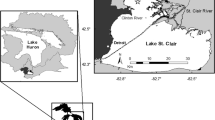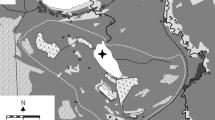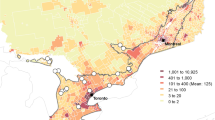Abstract
The CASSARINA Project is a co-ordinated joint study of recent environmental change in North African wetland lakes. Nine primary sites were selected for detailed study comprising three sites in each of Morocco, Tunisia and Egypt. Multi-disciplinary studies were undertaken by scientists from each of these countries working in co-operation with colleagues in the UK and Norway. The detailed results are presented in a consecutive suite of papers that describe both modern ecosystem attributes and the recent environmental histories of each site. This paper presents an overview of the aims, structure and initial results of the project.
Modern site attributes measured were water quality and phytoplankton (Fathi et al., 2001), zooplankton (Ramdani et al., 2001b), fish (Kraïem et al., 2001) and littoral vegetation (Ramdani et al., 2001a). Baseline water quality data showed that one site (Megene Chitane) was acid with low salinity but the others had high alkalinities with varying degrees of brackishness. All the sites tended to be eutrophic and the phytoplankton was mainly dominated by green or blue-green algae. Where fish were present, growth rates were high with marginally highest rates in the Egyptian Delta lakes (Kraïem et al., 2001). Marginal vegetation surveys showed that emergent macrophytes were still extensive only in the Delta lakes (Ramdani et al., 2001a) where they form important refuges and restrict water pollution. In 1998, one Moroccan wetland lake (Merja Bokka) was drained completely for cultivation.
Site specific environmental change records for the 20th century period were obtained using palaeolimnological techniques. Sediment core chronologies (Appleby et al., 2001) were based mainly on radio-isotopes (210Pb and 137Cs). Sedimentary remains of aquatic biota, diatoms, zooplankton, higher plants and benthic animals (Flower et al., 2001; Ramdani et al., 2001c; Birks et al., 2001a) and pollen (Peglar et al., 2001) were investigated (Birks et al., 2001b). Major differences in past species abundances were found and were interpreted in terms relevant to biodiversity and water quality/availability change. Metals and pesticide residues in sediment cores indicated that lake contamination was generally lower than in some European sites but some DDE profiles showed a close correspondence with known usage histories (Peters et al., 2001).
Hydrological changes affecting water quality and availability mainly arose from land-use intensification during the 20th century and are shown to be the main driver of biodiversity disturbance at all nine CASSARINA sites. Summarizing floristic and faunistic changes using species richness values indicated that freshening of the Delta lakes during this century generally increased aquatic diversity. Species richness also increased during the final drainage of Bokka but tended to decline in acid Chitane. Modern sampling showed that phytoplankton and epiphytic diatom diversity was higher in the Delta lakes but this was not so for zooplankton. Each biological group reacted differently to environmental disturbance and this lack of concordance makes overall diversity changes difficult to predict.
Similar content being viewed by others
References
Appleby PG, Birks HH, Flower RJ, Rose N, Peglar SM, Ramdani M, Kraïem MM and Fathi AA (2001) Radiometrically determined dates and sedimentation rates for recent sediments in nine North African wetland lakes (the CASSARINA Project). Aquat Ecol 35: 347-367
Arbouille D and Stanely DJ (1991) Late Quaternary evolution of the Burullus lagoon region, north central Nile Delta, Egypt Mar Geol 99: 45-66
Banoub MW (1979) The salt regime of Lake Edku (Egypt) before and after the construction of Asswan's high dam. Arch Hydrobiol 85: 392-399
Battarbee RW (1991) Recent palaeolimnology and diatom-based environmental reconstruction. In: Shane LCK and Cushing EJ (eds.), Quaternary Landscapes. University of Minnesota Press, pp. 129-173
Ben Khalifa L (1989) Diatomées continentales et paléomilieux du Sud-Tunisien (PALHYDAF site 1) au Quaternaire supérieur. Unpubl PhD Thesis. Université de Paris-Sud, Centre D'Orsay. 339 pp
Ben Tiba B (1980) Contribution pollen analytique a l'historie Holocene de la végétation de Kroumirie (Tunisie Septentrionale). Unpublished PhD thesis. L'Université d'Aix-Marseille III
Benessaiah N and Belhaj M (eds.) (1999) Mediterranean wetlands socio-economic aspects. The MedWet Programme: Conservation and Wise use ofWetlands in the Mediterranean Basin. RAMSAR Convention Bureau, Gland, 155 pp
Berglund BE (1986) Handbook of Holocene Palaeoecology and Palaeohydrology. Wiley, Chichester
Bernasconi MP and Stanley DJ (1994) Molluscan biofacies and their environmental implications, Nile Delta lagoons, Egypt J Coastal Res 10: 440-465
Birks HJB (1996) Contributions of Quaternary palaeoecology to nature conservation. J Veg Sci 7: 89-98
Birks HH, Peglar SM and Bjune AE (2000) Lithostratigraphy and biostratigraphy (pollen, macrofossil, molluscs, ostracods) of the secondary sediemnt cores from the CASSARINA sites, and heavy metal stratigraphy of the primary cores. Final CASSARINA Results report. Unpublished Report. Botanical Institute, University of Bergen, Norway
Birks HH, Peglar SM, Boomer I, Flower RJ, Ramdani M, with contributions from Appleby PG, Bjune AE, Patrick ST, Kraïem MM, Fathi AA and Abdelzaher HMA (2001a) Palaeolimnological responses of nine North African lakes in the CASSARINA Project to recent environmental changes and human impacts detected by plant macrofossil, pollen, and faunal analyses. Aquat Ecol 35: 405-430
Birks HH and Birks HJB, with contributions from Flower RJ, Peglar SM and Ramdani M (2001b) Recent ecosystem dynamics in nine North African lakes in the CASSARINA Project. Aquat Ecol 35: 461-478
Biswas AK (1993) Land resources for sustainable agricultural development in Egypt. Ambio 22: 556-560
Blanc M (1954) La répartition des poissons d'eau douce africans. Bull Inst Français d'Afrique Noire 16: 599-628
Boesch DF, Josselyn MN, Mehta AJ, Morris JT, Nuttle WK, Simenstad C A and Swift DPJ (1994) Scientific assessment of coastal wetland loss, restoration and management in Louisiana. J Coastal Res (Special Issue) 20: 103 pp
Boulenger GA (1907) Zoology of Egypt, The Fishes of the Nile. Hugh Rees, London
Brown DS (1994) Freshwater Snails of Africa and their Medical Importance, 2nd edition. Taylor and Francis, London.
Chergiu H, Pattee E, Essafi K and Mhamdi M A (1999) Moroccan Limnology. In: RG Wetzel and B. Gopal (eds.) Limnology in Developing Countries, SIL Publication 2: 235-330
Connell, JH (1987) Diversity in tropical rainforests and coral reefs. Science 199: 1302-1310
Dakki M, Baouab RE and El Agbani MA (1991) Recensement hivernal d'oiseaux d'eau au Maroc: Janvier, 1991. Documents de l'Institut Scientifique, Université Mohammed V. Rabat No. 14: 17 pp
Davis TJ (1994) The Ramsar Convention Manual: A guide to the Convention on Wetlands of International Importance Especially as Waterfowl Habitats. Ramsar Convention Bureau, Gland, 207 pp
Drainage Research Institute (1997) A Water Quality Baseline for Bahr El Baqar Drain and Lake Manzala as Affected byWastewater. Final Report to the Department of International Development (UK) by the Drainage Research Institute, Ministry of Public Works and Water Resources, National Water Research Centre, Cairo, Egypt
Dugan PJ (ed.) (1993) Wetlands in Danger. M. Beazley, London, 187 pp
Duning L, Xinghen H and Xianli YW (1996) Protection of littoral wetlands in North China, ecological and environmental characteristics. Ambio 25: 2-5
El Amani S (1977) Utilization of runoff waters, the meskats and other techniques in Tunisia. African Environ 3: 107-120
El-Sherif ZM (1993) Phytoplankton standing crop, diversity and statistical multispecies analysis in Lake Burollus, Egypt. Bull Nat Inst Ocean Fish, Arab Republic of Egypt 19: 213-233
Farinha JC, Costa LT, Zalidis GC, Mantzavelas AL, Fitoka EN, Hecker N and Tomas Vives P (1996) Mediterranean wetland Inventory: Habitat Description System. MedWet/IUCN. Publication Volume No. IV
Fathi AA, Abdelhazer HMA, Flower RJ, Ramdani M and Kraïem MM (2001) Phytoplankton communities of North African wetland lakes: the CASSARINA Project. Aquat Ecol 35: 303-318
Feldmann G (1946) Les Charophycées d'Afrique du Nord. Bull Soc Hist Nat Afr Nord 37: 64-118
Fennane M, Ibn Tattou M, Matheez J, Ouyahya A and El Oualidi J (199) Flore Pratique du Maroc. Vol. 1. Trav. Instit. Scient. Série Botanique, No. 36. Rabat, 588 pp
Finlayson M, Hollis T and Davis T (1992) Managing Mediterranean Wetlands and their Birds. IWRB Spec. Publ. No. 20. Slimbridge, 285 pp
Finlayson M and Moser M (eds.) (1992) Wetlands, Facts on File. Oxford University Press, Oxford, 224 pp
Flower RJ, Dearing JA and Nawas R (1984) Sediment supply and accumulation in a small Moroccan lake: an historical perspective. Hydrobiologia 112: 81-92
Flower RJ, Dearing J, Rippey B, Foster IDL, Appleby PG and Wilson JFP (1989) Catchment disturbance inferred from palaeolimnological studies of three contrasted sub-humid environments in Morocco. J. Paleolimnol 1: 293-322
Flower RJ, Ramdani M, Kraïem MM, Fathi AA, Al-Khudhary DHA, Birks HH, Patrick ST, Stevenson AC (1998) The CASSARINA Project and the application of remote sensing techniques. In: Satellite-based Observation: A Tool for the Study of the Mediterranean Basin. JL Fellous et al. (eds.), Proc. of an International Symposium, Tunis 23-27th November 1998. Centre National d'Etudes Spatial, Toulouse, pp. 219-224
Flower RJ and Patrick ST (eds.) (1997) CASSARINA Project Manual: Suggested Fieldwork Procedures and Laboratory Techniques. ECRC Research Report No. 48. University College, London
Flower RJ, Dobinson S, Ramdani M, Kraïem MM, Ben Hamza C, Fathi AA, Abdelzaher HMA, Birks HH, Appleby PG, Lees JA, Shilland E, and Patrick ST (2001) Recent environmental change in North African wetland lakes: diatom and other stratigraphic evidence from nine CASSARINA sites. Aquat Ecol 35: 369-388
Gasse F, Fontes JC, Plaziat JC, Carbonel P, Kacmarska I, De Dekker P, Soulie-Marsche I, Callot Y and Dupeuble PA (1987) Biological remains, geochemistry and stable isotopes for the reconstruction of environmental and hydrological changes in the Holocene lakes from North Sahara. Palaeogeography, Palaeohydrology, Palaeoecology 60: 1-46
Gaston K (1994) Rarity. Chapman and Hall, London.
Gaultier H (1937) Ostracodes and Cladocères de l'Afrique du Nord. Note 4. Bull Soc Hist Nat l'Afr Nord 28: 147-156
Gauthier-Lievre L (1931) Recherches sur la flore des eaux continentales de l'Afrique du Nord, Soc Hist Nat Afr Nord 299 pp
Gayral P (1954) Recherches phytolimnologique au Maroc. Trav Inst Sci Cherfif (Tangier) 4: 1-306
GEO 2000 (1999) Global Environment Outlook (2000) UNEP/Earthscan. Earthscan Publications, London, 386 pp
Gharib SM (1999) Phytoplankton studies in Lake Edku and adjacent waters, Egypt. J Aquat Biol Fish 1: 1-23
Glowka L, Burhenne-Guilmin F and Synge H (1994) A guide to the Convention on Biological Diversity. IUCN, Gland, Switzerland
Goodman SM and Meininger PL (1989) The Birds of Egypt. Oxford University Press, Oxford, 489 pp
Hall LW and Anderson RD (1995) The influence of salinity on the toxicity of varoius classes of chemicals to aquatic biota. Crit Rev Toxicol 25: 281-346
Haywood VH (ed.) (1995) Global Biodiversity Assessment. Cambridge University Press, Cambridge, 1140 pp
Hollis GE (1986) The modelling and management of the internationally important wetland at Garaet El Ichkeul, Tunisia. IWRB Spec. Pub. No. 4. IWBR, Slimbridge.
Hollis GE (1992) Implications of climatic changes in the Mediterranean basin: Garaet El Ichkeul and Lac de Bizerte, Tunisia. In: L Jeftic, JD Miliman and G sestine (eds.), Climatic Change and the Mediterranean. Edward Arnold, London, 603-665 pp.
Howa HL and Stanely DJ (1991) Plant-rich Holocene sequences in the northern Nile Delta plain, Egypt: petrology, distribution and depositional environments. J Coastal Res 7: 1077-1096
Hughes JMR, Ayache F, Hollis T, Mamouri F, Avis C, Giansante C and Thompson J (1997) A Preliminary Inventory of Tunisian Wetlands. Report to EEC (DG XII), RAMSAR Bureau and US Fish and Wildlife Service. Wetland Research Unit. Dept. of Geography. University College, London, 473 pp
Kasperson RE, Kasperson JX and Turner BL (1999) Risk and criticality: trajectories of regional environmental degradation. Ambio 28: 562-568
Kerambrun P (1986) Coastal lagoons along the southern Mediterranean Coast (Algeria, Egypt, Libya, Morocco, Tunisia) Descriptions and Bibliography. UNESCO Reports in Marine Science 34, UNESCO, Paris, 163 pp
Kraïem MM (1987) Contribution à l'hydrobiologie du réseau hydrographique de l'Ichkeul (Tunisie septentrionale). Archs Inst Pasteur Tunis 64 (4): 463-475
Kraïem MM, Ben Hamza C, Ramdani M, Fathi AA, Abdelhazer HMA and Flower RJ (2001) Some observations on the age and growth of thin-lipped grey mullet, Liza ramada Risso, 1826 (Pisces, Mugilidae) in three North African wetland lakes: Merja Zerga (Morocco), Garaat Ichkeul (Tunisia) and Edku Lake (Egypt); Aquat Ecol 35: 335-345
Matoussi MS (1996) Sources of strain and alternatives for relief in the most stressed water systems of North Africa. In: E Rached, E Rathgeber and D Brooks (eds.), Water Management in Africa and the Middle East. International Development Centre. Ottawa, pp. 94-106
Mehringer PJ, Petersen KL and Hassan FA (1979) A pollen record from Birket Qarun and the recent history of the Fayum, Egypt. Quat Res 11: 238-256
Morgan NC and Boy V (1982) An ecological survey of standing waters in North West Africa: Rapid survey and classification. Biol Cons 24: 5-44
Moss B (2000) Biodiversity in fresh waters-an issue of species preservation or system functioning? Environ Cons 27: 1-4
Pearse F (1996) Wetlands and water resources. In: J Skinner and AJ Crivelli (eds.), Conservation of Mediterranean Wetlands-MedWet. Series. Tour du Valat, No. 5, 82 pp
Peglar SM, Birks, HH, Birks HJB, with contributions from Appleby PG, Fathi AA, Flower RJ, Kraïem MM, Patrick ST and Ramdani M (2001) Terrestrial pollen record of recent land-use changes around nine North African lakes in the CASSARINA Project. Aquat Ecol 35: 431-448
Peters AJ, Jones KC, Flower RJ, Appleby PG, Ramdani M, Kraïem MM and Fathi AA (2001) Recent environmental change in North African wetland lakes: a baseline study of organochlorine contaminant residues in sediments from nine sites in the CASSARINA Project. Aquat Ecol 35: 449-459
Ramdani M (1988) Les eaux stagnates au Maroc: étude biotypologique et biogéographique du zooplankton. Travaux Inst Scient, Serie Zoologie 43: 1-40
Ramdani M and Elkhiati N (2000) Vegetation transects, water analysis, zooplankton analysis of open waters, zooplanktonic and benthonic fauna analyses in sediments cores of all investigated lakes. Final CASSARINA Results Report. Internal report: Dept. of Zoology and Animal Ecology, Institute Scientifique, Rabat and Dept. of Biology, Faculty of Sciences, University of Ain Chok, Casablanca
Ramdani M, Flower RJ, Elkhiati N, Kraïem MM, Fathi AA, Birks HH and Patrick ST (2001a) North African wetland lakes: characterization of nine sites included in the CASSARINA Project. Aquat Ecol 35: 281-302
Ramdani M, Elkhiati N, Flower RJ, with contributions from Birks HH, Kraïem MM, Fathi AA and Patrick ST (2001b) Open water zooplankton communities in North African wetland lakes: the CASSARINA Project. Aquat Ecol 35: 319-333
Ramdani M, Flower RJ, Elkhiati N, with contributions from Birks HH, Kraïem MM and Fathi AA (2001c) Zooplankton (Cladocera, Ostracoda), Chironomidae and benthic fauna remains in sediment cores from nine North African wetland lakes: The CASSARINA Project. Aquat Ecol 35: 389-403
Reille M (1979) Analyse pollinique du lac Sidi Bou Rhaba. Ecologia Mediterranea 4: 61-65
Renberg I, Persson MW and Emteryd O (1994) Pre-indistrial atmopsheric lead contaminatoin deteched in Swedish lake sediments. Nature 368: 323-236
Rosenzweig ML (1995) Species Diversity in Space and Time. Cambridge University Press, Cambridge, 436 pp
Saad MAH (1973) Catastrophic effects of pollution on Egyptian waters near Alexandria. Coll Int Oceanogr Med Messina 5: 553-573
Saad MAH, McComas SR and Eisenreich SJ (1985) Metals and chlorinated hydrocarbons in surficial sediments of three Nile Delta lakes, Egypt. Water, Air, Soil Pollut 24: 27-39
Schindler DW (1987) Detecting ecosystem responses to anthropogenic stress. Can J Fish Aquat Sci 44: 6-25
Shahin M (1985) Hydrology of the Nile Basin. Elsevier, Amsterdam, 575 pp
Shaheen AH and Yousef SF (1980) Physico-chemical conditions, fauna and flora of Lake Manzala, Egypt. Water Supply Manag 4: 103-113
Siegal FR, Slaboda ML and Stanley DJ (1994) Metal pollution loading, Manzala Lagoon, Nile Delta, Egypt: implications for agriculture. Environ Geol 23: 89-98
Skinner J and Zalewski S (1995) Functions and Values of Mediterranean Wetlands. In: J Skinner and S Zalewski (eds.), Conservation of Mediterranean Wetlands-MedWet. Series. MedWet/Tour du Valat, No. 2. 80 pp
Smol JP (1990) Are we building enough bridges between paleolimnology and aquatic ecology? Hydrobiologia 214: 201-206
Smol JP (1992) Paleolimnology: an important tool for effective ecosystem management. J. Aquatic Ecosystem Health 1: 49-58
Stanley DJ and Warne AG (1993) Nile Delta: Recent geological evolution and human impacts. Science 260: 628-634
Stevenson AC and Battarbee RW (1991) Palaeoecological and documentary records of recent changes in Garaet El Ichkeul: a seasonally saline lake in N.W. Tunisia. Biol Cons 58: 275-295
Sultan M, Fiske M, Stein T, Gamal M, El Aradby H, Madani A, Mehanee S and Becker R (1999) Monitoring the urbanization of the Nile Delta, Egypt. Ambio 28: 628-631
Takholme V and Drar M (1950) Flora of Egypt. Fouad I University Press, Cairo.
Talling JF and Lemoalle J (1998) Ecological Dynamics of Tropical Inland Waters. Cambridge University Press, Cambridge, 441 pp
Thevenot M (1976) Les oiseaux de la reserve de Sidi Bou Rhaba. Bull Inst Scient, Rabat, 1: 68-90
Tilman D, Fargione J, Wolff B, D'Antonio C, Dobson A, Howarth R, Schindler D, Sclesinger W. Simberloff D and Swackhamer D (2001) Forcasting agriculturally driven global environmental change. Science 292: 281-284
Tokeshi M (1999) Species Coexistence. Ecological and Evolutionary Perspectives. Blackwell Science, Oxford, 454 pp
Turner BL, Skole D, Sanderson S, Fischer G, Fresco L and Leemans R (1995) Land-Use and Land-Cover Change. IGBP Report No. 35, HDP Report No. 7. Stockholm and Geneva
UNECA (1991) Cairo common position on the African Environment and Development Agenda. Report of the African Regional Conference for the UN Conference on the Environment and Development (UNCED), UNECA. Addis Abbaba, Ethiopia
Wetzel RG (1975) Limnology. WB Saunders, Philadelphia, 743 pp
Wetzel RG and Gopal B (1999) Limnology in Developing Countries. SIL Publication 2, 330 pp
Van Heerden IL (1994) A Long-term Comprehensive Management Plan For Coastal Louisiana to Ensure Sustainable Biological Productivity, Economic Growth, and the Continued Existence of Its Unique Culture and Heritage. Baton Rouge, LA: Louisiana State University, Center for Coastal, Energy, and Environmental Resources. 45 ppx
Author information
Authors and Affiliations
Rights and permissions
About this article
Cite this article
Flower, R. ChAnge, Stress, Sustainability and Aquatic ecosystem Resilience In North African wetland lakes during the 20th century: an introduction to integrated biodiversity studies within the CASSARINA Project. Aquatic Ecology 35, 261–280 (2001). https://doi.org/10.1023/A:1011978420737
Issue Date:
DOI: https://doi.org/10.1023/A:1011978420737




